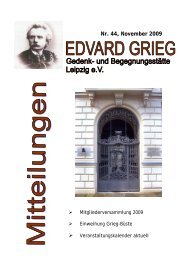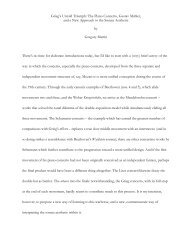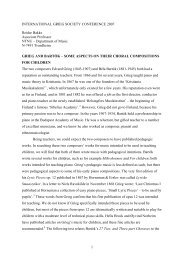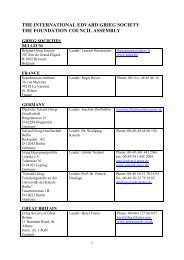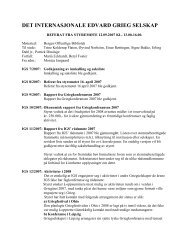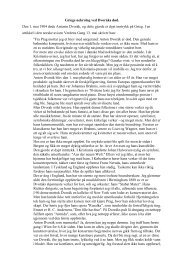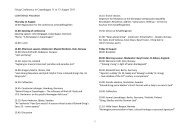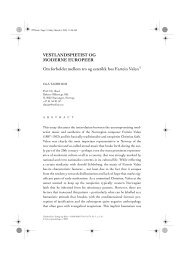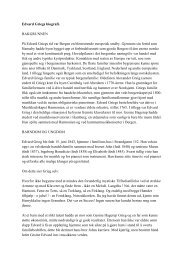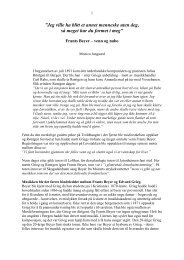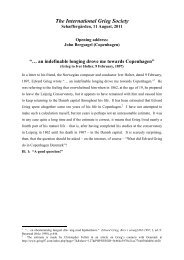Gregory Martin - paper 2007 - Grieg Society
Gregory Martin - paper 2007 - Grieg Society
Gregory Martin - paper 2007 - Grieg Society
You also want an ePaper? Increase the reach of your titles
YUMPU automatically turns print PDFs into web optimized ePapers that Google loves.
<strong>Grieg</strong> as Storyteller: the Poetics of the Ballade in G Minor, Op. 24<br />
<strong>Gregory</strong> <strong>Martin</strong><br />
We are of north-Teutonic stock, and as such we have much of the Germanic<br />
people’s propensity toward melancholy and brooding. However, we do not share<br />
their desire to express themselves broadly and verbosely. To the contrary. We<br />
have always loved brevity and succinctness, the clear and concise mode of<br />
expression—just as you can find it in our sagas, and as any traveler could observe<br />
even today in our social intercourse. These qualities are also what we aim for in<br />
our artistic endeavors. 1<br />
When Edvard <strong>Grieg</strong> penned this observation in 1900, he said as much about<br />
himself as about Norwegians in general. His recognition of the manner in which language<br />
and its use inform and reflect a people is brought into acute relief, a sensitivity further<br />
underscored in his letter of the same year to the American musicologist Henry T. Finck,<br />
in which he reflects that<br />
the lyricism of, respectively, German, Danish and Norwegian poets is for the<br />
attentive observer so totally different that the music, too, must be equally varied<br />
in order that the contrasts among the several nationalities can be perceived, yet<br />
not in such a way that the differences can be precisely described verbally. 2<br />
Linguistic identity was, of course, a primary agent in nineteenth-century European<br />
national movements. <strong>Grieg</strong>’s dialogue with the advocates of both nynorsk and riksmål is<br />
well enough known to need no further elaboration here. Rather, it is a corollary to the<br />
language debate that I’d like to investigate with respect to the Ballade—the citing of a<br />
great national epic which valorized the deeds and spirit of a people. These works were<br />
often the source of inspiration for the great nationalist composers, from the<br />
Nibelungenlied in Wagner to the Kalevala in Sibelius (though Wagner’s work is in fact<br />
1 Edvard <strong>Grieg</strong>, “French and German Music” in Edvard <strong>Grieg</strong>, Diaries, Articles, Speeches, trans. and ed.<br />
Finn Benestad and William H. Halverson (Columbus: Peer Gynt Press, 2001), 352.<br />
2 Edvard <strong>Grieg</strong>, Edvard <strong>Grieg</strong>, Letters to Colleagues and Friends, ed. Finn Benestad and trans. William H.<br />
Halverson (Columbus: Peer Gynt Press, 2000), 230.<br />
1
more Nordic than Germanic), 3 and the national language was seen as a link to the<br />
extraordinary past in which these tales played out. In this context, it is my purpose to<br />
submit that it was <strong>Grieg</strong>’s dramatic collaborations with riksmål devotee Bjørnstjerne<br />
Bjørnson that most immediately left their mark on his most profound work for solo<br />
piano—the Ballade in G minor, Op. 24 (1875-6)—and that the source of those<br />
collaborations lead to the unique poetics of this work, making it <strong>Grieg</strong>’s contribution to<br />
the great tradition of the Norse epic.<br />
* * *<br />
In a letter to composer and conductor Iver Holter (1850-1941) dated 9 February 1897,<br />
<strong>Grieg</strong> wrote: “It is a sacred duty for me to call attention to the great influence that my<br />
association with Bjørnson from the autumn of 1866 to the spring of 1873 had on my art.<br />
He formed my personality in countless ways—that is to say, he contributed mightily to<br />
that process.” 4 And of those eight years or so, the final three were particularly productive,<br />
yielding no less than five major dramatic works. Whether written as a setting of an<br />
already completed poetical work or through cooperation with the author, each of these is<br />
based on the Norse sagas or saga themes, and it is of no small significant for my<br />
argument vis-à-vis the Ballade (1875) that these collaborations all occurred between<br />
1871 and 1873:<br />
● 1871, Foran Sydens kloster, Op. 20—text taken from Bjørnson’s epic cycle<br />
Arnljot Gelline, the namesake of which is a character in the saga of St. Olav (Olav<br />
Haraldsson) by Snorri Sturluson<br />
3 Also to be mentioned in this context is the new value that the fairy-tale took on as a tool to stroke<br />
nationalist sentiment: P. C. Asbjørnsen and Jørgen Moe in Norway, Hans Christian Andersen in Denmark,<br />
and the Grimm Brothers in the German states, to name a few.<br />
4 <strong>Grieg</strong>, Letters, 419.<br />
2
● 1871, the melodrama Bergliot, Op. 42—Bergliot was one of the chief female<br />
characters from the saga era and the wife of Einar Tambarskjelve (died c. 1050)<br />
● 1872, the incidental music to Sigurd Jorsalfar, Op. 22—Bjørnson’s play<br />
concerns two Norwegian rulers from the twelfth century, Sigurd the Crusader and<br />
his brother Øystein<br />
●1872, the cantata Landkjending (Land-sighting), Op. 31—written to raise money<br />
for the restoration of Nidaros Cathedral in Trondheim, the text deals with Olav<br />
Trygvason’s return to Norway in 995 after his years abroad<br />
● 1873, the ‘operatic scenes’ Olav Trygvason, Op. 50—a continuation of the story<br />
of Olav’s arrival in Norway as begun in Landkjending, elaborating on his<br />
conquest and conversion of the people 5<br />
In addition, <strong>Grieg</strong> and Bjørnson briefly deliberated the prospect of an opera based on<br />
Arnljot Gelline, from which the text to Foran Sydens kloster had been drawn. 6<br />
These works not only incorporate the Norse epics topically, but draw much of<br />
their power from formal relations with the older examples. In Foran Sydens kloster<br />
(Before a Southern Convent), op. 20, for example, the textual layout, a dialogue between<br />
Ingigerd and the abbess, resembles such precedents as Gylfaginning (The Beguiling of<br />
Gylfi) in the Prose Edda, a lengthy tract on Norse mythology cast as a conversation<br />
between Gylfi and three supernatural beings. As Beryl Foster has observed, “the<br />
conciseness of the dialogue, the form of question and answer to unfold the tale, is<br />
5 While <strong>Grieg</strong> and Bjørnson were never able to complete their opera, composer Ragnar Søderlind and<br />
librettist Knut Jørgen Moe did in 2000.<br />
6 Finn Benestad and Dag Schjelderup-Ebbe, Edvard <strong>Grieg</strong>, The Man and the Artist, trans. William H.<br />
Halverson and Leland B. Sateren (Lincoln: University of Nebraska Press, 1988), 152.<br />
3
eminiscent of an older form of storytelling.” 7 So much were these works patterned on<br />
the mediaeval genres and so obscure were some of their references that <strong>Grieg</strong> later asked<br />
the playwright to<br />
do yourself, me, all the performers and audience the great service of attaching an<br />
explanation of the words underlined in blue in the accompanying text . . . One<br />
would like to know what the often metaphorically symbolized god is called and<br />
what he is god of, together with the meaning of several place names. You will<br />
forgive me this nuisance, but I lack the necessary mythological knowledge to<br />
manage it myself… 8<br />
It is clear from the composer’s letter to Finck some thirty years later that his immersion in<br />
the sagas left a grave impact on him and his understanding of their value as a reflector of<br />
his people:<br />
Norwegian folk life, Norwegian sagas, Norwegian history, and above all<br />
Norwegian nature have had a profound influence on my creative work ever since<br />
my youth. 9<br />
Later in the same letter he elaborates:<br />
Anyone who reads the Elder Edda soon becomes aware of its wonderful power<br />
and pithiness of expression, its remarkable ability to say much in a few words.<br />
Such a reader will admire the simple, plastic formulation of the sentences. The<br />
same is true of the sagas about the Norwegian kings, especially those written by<br />
Snorre Sturlason. The more deeply the heart is moved, the more condensed and<br />
enigmatic is the mode of expression. The language is constantly bold, serious and<br />
dignified. One senses more than one sees the stormy ocean of the passions. To<br />
display one’s innermost feelings was considered brutal. For the feelings, too, the<br />
mode of expression is as brief as it is chaste. This saga literature is the foundation<br />
on which Bjørnson and Ibsen built. 10<br />
7 Beryl Foster, Edvard <strong>Grieg</strong>: The Choral Music (Aldershot, England; Brookfield, Vermont: Ashgate<br />
Publishing, 1999), 94.<br />
8 <strong>Grieg</strong> quoted in Foster, Choral Music, 114.<br />
9 <strong>Grieg</strong>, Letters, 226.<br />
10 Ibid., 230-1.<br />
4
Edvard <strong>Grieg</strong> and Bjørn Bjørnson in a 19 th -century caricature (public domain)<br />
In 1875, then, when <strong>Grieg</strong> came to compose his sole contribution to the piano<br />
ballade repertoire, it was on the heels of these dramatic compositions and after an<br />
extended period of immersion in the sagas and Eddas. 11 Both of his parents had recently<br />
died, and rumors were circulating that his wife had had an affair with his brother John, 12<br />
leaving the composer to later write that he had written his opus 24 “with my life’s blood<br />
in days of sorrow and despair.” 13<br />
The Ballade is ostensibly a set of variations on the folksong “Den nordlanske<br />
bondestand” (The Northland Peasantry) as found in L. M. Lindeman’s publication Ældre<br />
11 The composition of incidental music to Ibsen’s Peer Gynt, which Bjørnson mistakenly took to be another<br />
operatic project, resulted in a rift between composer and author, and the breakdown of work on their<br />
national opera Olav Trygvason.<br />
12 Benestad, 199.<br />
13 Ibid., 200.<br />
5
og nyere norske Fjeldmelodier (Older and Newer Norwegian Mountain Melodies, 1858;<br />
volume two, number fourteen). While the tune had migrated from Germany to Norway<br />
over the course of several hundred years with various sacred and secular texts, 14 <strong>Grieg</strong><br />
found it paired with the following text:<br />
E kann so mangen ein’ vakker Sang I know so many lovely songs<br />
um fagre land uti Væra,<br />
of fair lands throughout the world,<br />
men aldør ha e no høyrt ei Gøng<br />
but never have I heard a song<br />
dei sang um dœ o ser næra,<br />
of things close to us.<br />
derfor vil e no prøvø paa<br />
Therefore shall I now attempt<br />
o gjera Visa so Følk kan sjaa<br />
to write a song so people will see<br />
at o her Nora kunna vera bra<br />
that even the North can be beautiful<br />
um dœ foragta der søre. though despised by the South. 15<br />
Such earnest nationalism surely rang true with his allegiance to Norway and his<br />
devotion to the development of a Norwegian art, but <strong>Grieg</strong> used folksong throughout his<br />
career and the text of “The Northland Peasantry” can be seen as a credo for his entire<br />
life’s work. How are these elements uniquely engaged in this work? And why use a song<br />
without any real story, so to speak, as the foundation for a work so self-consciously<br />
aligned with an unmitigated narrative genre? Perhaps the answer lies in <strong>Grieg</strong>’s view of<br />
the historical course of folksong: “The music of each nation proceeds in the course of<br />
time from the folk song through the small forms and then into the larger, richer, more<br />
complex forms.” 16 The key sentiment in the text is “I now attempt to write a song.” But<br />
<strong>Grieg</strong>’s narrative is not just of a declamation of intent by some nameless skald. Rather, it<br />
is a chronicle of that attempt’s progress. Containing both the folksong itself and its<br />
‘larger,’ evolved form, the Ballade is a narrative of the growth of folksong; and, through<br />
14 Ibid. This historical example affords a wonderful illustration of how intuitively <strong>Grieg</strong> understood the<br />
Norwegian folk-song. In the above-cited letter to Finck (17 July 1900), he wrote: “that many of our oldest<br />
folk tunes are based on old hymns seems to me to be beyond doubt (<strong>Grieg</strong>, Letters, 229).”<br />
15 The history of the tune is taken from Einar Steen-Nøkleberg and Ernst Herttrich, preface to Ballade, op.<br />
24, by Edvard <strong>Grieg</strong> (Munich: G. Henle Verlag, 1991), vi, and Benestad and Schjelderup-Ebbe, 201. The<br />
translation is from Steen-Nøkleberg and Herttrich.<br />
16 <strong>Grieg</strong>, Diaries, 219.<br />
6
the application of folksong as an ambassador of his people, it is the story of the<br />
Norwegian struggle for not only independence, but recognition (i.e. cultural and political<br />
legitimacy in the eyes of the Continent). Political overtones aside, there is also certainly<br />
something of a personal quest contained in this mission statement. “People will see that<br />
even the North can be beautiful.”<br />
Given his recent immersion in the sagas and Eddas and cognizant of their role in<br />
Norwegian identity, it seems only natural that he would fit his tale with a design<br />
intuitively reflective of his people; witness again the opening quotation, especially the<br />
following extraction: “We have always loved brevity and succinctness, the clear and<br />
concise mode of expression—just as you can find it in our sagas.” The equation of<br />
variation form with the strophic structure of folksong in the 19 th century has been well<br />
documented—perhaps the most overt acknowledgement by a major composer of the era<br />
is found in Sibelius’s 1896 lecture at the University of Helsinki, wherein he contends that<br />
variations are the closest formal analogue in ‘high art’ to folk music. 17 But it is not<br />
simply folksong that <strong>Grieg</strong> is acknowledging here. He is aiming at the sublime depth and<br />
substance of the mediaeval epics of Norway, and variation form is appropriated for that<br />
purpose—not as a reflection of nondescript stanzaic form, but as a specific generic<br />
reference. The particular manipulation of the variation form found in the Ballade, in<br />
which the earlier character variations build up to the later additive-verse structure, is<br />
crucial to his story’s unfolding, and indeed supports Aristotle’s definition of an epic, as<br />
we shall see. This, then, is <strong>Grieg</strong>’s great contribution to the ballade: fitting the story with<br />
17 Indeed, recognition of this parallel with regard to the Ballade has been made (Parakilas, 159), and the<br />
suggestion that <strong>Grieg</strong> equated ballad form with variations is perhaps supported by his decision to base his<br />
Old Norwegian Romance with Variations, op. 51 (1890) on a ballad, ‘Sjugurd og trollbrura’ (Sjugurd and<br />
the Troll Bride).<br />
7
a form generically reflective of it—the Ballade belongs as much or more-so with the<br />
sagas and Eddas than it does with Chopin’s examples. 18<br />
But, as <strong>Grieg</strong> well knew, writing a saga and espousing its characteristics means<br />
more than simply formal procedures; there are vital aspects of genre at issue, among<br />
which are epic notions of time and duration, the role of the narrator/storyteller (an<br />
element introduced in the text—“I now attempt to write a song”), and the air of austerity<br />
prevalent in such tales. The last of these is perhaps the most subjective in its evaluation; it<br />
relates both to the vocabulary used—for the language of the epic is indivisible from its<br />
story—and ties in with perceptions of how Nordic landscape is reflected in <strong>Grieg</strong>’s<br />
music. I will not attempt to investigate this quality here; it is a familiar enough trope, and<br />
has been explored thoroughly elsewhere. 19 Suffice it to say that pianist Sviatoslav Richter<br />
spoke for not a few of us when he said: “in my own view he’s [<strong>Grieg</strong>] essentially an<br />
austere individual, like the landscape and nature of the North.” 20<br />
The epic as a genre cannot be separated from the great gulf of time implied, by its<br />
very nature, between ‘then’ and ‘now.’ Aristotle noted that “its action has no fixed limit<br />
of time.” M.M. Bakhtin elaborated on this quality in The Dialogic Imagination: Four<br />
Essays, where he posits that “a national epic past—in Goethe’s and Schiller’s<br />
18 While James Parakilas does credit <strong>Grieg</strong>’s Ballade with being “a new venture—within the piano ballade<br />
tradition—in suggesting both the form of the song and the progression of the story (pg. 159),” he fails to<br />
recognize <strong>Grieg</strong>’s reasons for doing so (poetically and formally), and as a result, I believe, does not<br />
evaluate the work appropriately in terms of intent, proportion, or design.<br />
19 See, for example, Daniel Grimley, <strong>Grieg</strong>: Music, Landscape and Norwegian Identity (Rochester: Boydell<br />
Press, 2006).<br />
20 Sviatoslav Richter, in Bruno Monsaingeon, Sviatoslav Richter: Notebooks and Conversations, trans.<br />
Stewart Spencer (London: Faber, 2005), 319-20.<br />
8
terminology the ‘absolute past’—serves as the subject for the epic.” 21 He elaborates as<br />
such:<br />
The world of the epic is the national heroic past: it is a world of “beginning” and<br />
“peak times” in the national history, a world of fathers and of founders of<br />
families, a world of “firsts and “bests.”. . . the represented world of the heroes<br />
stands on an utterly different and inaccessible time-and-value plane, separated by<br />
epic distance. The space between them is filled with national tradition.. . . In<br />
ancient literature it is memory, and not knowledge, that serves as the source and<br />
power for the creative impulse. That is how it was, it is impossible to change it:<br />
the tradition of the past is sacred. 22<br />
Bakhtin adds that “an absolute epic distance separates the epic world from contemporary<br />
reality”:<br />
Thanks to this epic distance, which excludes any possibility of activity and<br />
change, the epic world achieves a radical degree of completedness not only in its<br />
content but in its meaning and its values as well.. . . It is impossible to achieve<br />
greatness in one’s own time. Greatness always makes itself known only to<br />
descendents, for whom such a quality is always located in the past (it turns into a<br />
distanced image); it has become an object of memory . . . 23<br />
<strong>Grieg</strong>’s letters, speeches, and diaries are proof of his understanding that the sagas and<br />
Eddas are representative of a “peak time” in his nation’s history—a time of heroes. We<br />
shall see how he portrays the quality of epic distance in the Ballade.<br />
In the same essay, Bakhtin stresses the importance of national tradition over<br />
personal experience. He makes specific reference to the role of memory in the epic,<br />
noting that “it is memory, and not knowledge, that serves as the source and power for the<br />
creative impulse.” 24 That is, he articulates the importance of discriminating between the<br />
past, cumulative experience of a people and the current, subjective experiences of the<br />
individual. In his essay “The Storyteller: Reflections on the Works of Nikolai Leskov,”<br />
21 M.M. Bakhtin, The Dialogic Imagination: Four Essays, ed. Michael Holquist, trans. Caryl Emerson and<br />
Michael Holquist (Austin: University of Texas Press, 1981), 13.<br />
22 Ibid., 13-15.<br />
23 Ibid., 13, 17-18.<br />
24 Ibid., 15.<br />
9
Walter Benjamin bemoans the replacement of the legacy of shared experience by a more<br />
immediately accessible and disposable manner of communication: information. “If the art<br />
of storytelling has become rare,” he argues, “the dissemination of information has had a<br />
decisive share in this state of affairs.” 25 This sentiment had been articulated as early as<br />
1852 by Eduard Krüger, who mourned the decline of “the continual preservation of the<br />
after-echoes of that which has been experienced”; 26 John Daverio adds that art “thrives<br />
best in those societies whose members have retained the ability to exchange experiences,<br />
to tell stories.” 27 In the Leskov essay, Benjamin also writes:<br />
Experience which is passed on from mouth to mouth is the source from which all<br />
storytellers have drawn. And among those who have written down the tales, it is<br />
the great ones whose written version differs least from the speech of the many<br />
nameless storytellers. 28<br />
That <strong>Grieg</strong> was sensitive to the unique ability of a people’s language to reflect their<br />
psychology should be clear by now: “What the poets have achieved in this respect is what<br />
I have striven for in music,” he wrote. 29 Furthermore, regarding Den Bergtekne, op. 32,<br />
the only setting of mediaeval Norwegian that he completed, he wrote, “I have sought here<br />
to emulate the compact terseness of style that is expressed with such awesome power in<br />
the Old Norse poetry.” 30 This diagnosis, then, resonates well with Benjamin’s paradigm<br />
that the best storytellers write in a manner immediately reflective of their spoken<br />
language, and certainly <strong>Grieg</strong> meant his philosophy of “emulating the compact terseness”<br />
of Old Norse to apply beyond the single example of Der Bergtekne. It undoubtedly<br />
25 Walter Benjamin, “The Storyteller: Reflections on the Works of Nikolai Leskov,” in Illuminations, ed.<br />
Hannah Arendt (New York: Schocken Books, 1968), 89.<br />
26 Eduard Krüger, quoted in John Daverio, Robert Schumann, Herald of a “New Poetic Age” (New York &<br />
Oxford: Oxford University Press, 1997), 415.<br />
27 Ibid.<br />
28 Benjamin, 84.<br />
29 <strong>Grieg</strong>, Letters, 231.<br />
30 Ibid., 235.<br />
10
applies to a work such as the Ballade, as well as any host of his smallest folksong<br />
settings. In its way, each was an attempt to remedy this epidemic decay in storytelling. In<br />
the instance of the Ballade, he employs two main musico-dramatic functions to unfold<br />
the tale: 1) the gradual purging of chromatic elements from the theme; and 2) an<br />
acceleration, assisted by the gradual elision of variations, which leads—through a<br />
liquidation of motives and phrase structure—to the achievement of a literal timelessness.<br />
These progressions are assisted by a formal shift from what Aristotle called the ‘episodic’<br />
to the ‘tragic.’<br />
As a first step in examining these strategies, it is imperative to investigate <strong>Grieg</strong>’s<br />
handling of the theme. A comparison of his setting with the arrangement in his source<br />
(Lindeman) makes explicit one important difference: the harmonization (Ex.1 a and b).<br />
11
If we look at the harmonic treatment on a purely vertical level, we see one of <strong>Grieg</strong>’s<br />
most idiosyncratic harmonic tendencies: the placement of a chromatic scale under a<br />
diatonic melody, and the filling of the space thus created with an harmonic progression<br />
that doesn’t always sound functional. This technique was also employed in the Op. 66<br />
folksong settings, which had a profound influence on Bartok’s setting of folk music.<br />
Witness, for example, numbers 4 and 12 from that collection (Ex. 2 and 3, respectively).<br />
13
<strong>Grieg</strong> found this harmonic language to be the natural result of the folksongs themselves.<br />
He wrote:<br />
The realm of harmony has always been my dream-world, and the relation between<br />
my sense of harmony and Norwegian folk music has always been an enigma to<br />
me. I have found that the obscure depth in our folk melodies has its foundation in<br />
their undreamt-of harmonic possibilities. In my arrangements in op. 66 and<br />
elsewhere I have tried to give expression to my sense of the hidden harmonies in<br />
our folk tunes. In so doing I have been rather especially fascinated by the<br />
chromatic lines in the harmonic texture. 31<br />
In the case of the Ballade, given the difficult personal circumstances surrounding its<br />
composition, 32 the application of chromaticism seems particularly appropriate, for, as<br />
<strong>Grieg</strong> stated regarding his use of the chromatic,<br />
my ideal teachers were names such as Bach, Mozart, and Wagner. I have<br />
observed that when these immortal masters gave expression to their deepest and<br />
31 <strong>Grieg</strong>, Letters, 229.<br />
32 According to Iver Holter, who was present at <strong>Grieg</strong>’s play-through of the work for Dr. Max Abraham,<br />
director of Peters Publishing, in Leipzig (July 1876), <strong>Grieg</strong> threw so much of himself into the performance<br />
that “when he was finished, not only was he so physically exhausted that he was bathed in sweat: he was<br />
also so agitated and shaken that he could not say a word for a long time (Benestad, 200).” <strong>Grieg</strong> recalled, in<br />
a 1904 letter to Henri Hinrichsen, that, “when I was finished, however, to my surprise he [Abraham] said:<br />
‘A great, serious work which it will give me pleasure to publish and which will add even greater luster to<br />
your name (Ibid., note 3).’”<br />
14
most fervent thoughts they had a marked fondness for chromatic lines, each in his<br />
own original way. On this basis I quietly evolved little by little my own sense of<br />
the importance of the chromatic element. . . See [also] Ballade op. 24. 33<br />
Carl Dahlhaus found this combining of centuries-old folksongs with a late nineteenthcentury<br />
harmonic idiom to yield the creation of a dialectic between antiquity and<br />
34<br />
modernity. But more than this, through the juxtaposition of these two elements and<br />
their affiliated historical eras, <strong>Grieg</strong> succeeds in creating a great abyss of time—one of<br />
the most vital requirements in epic discourse, as we have seen. In his application of this<br />
device across his output, he not only accents the pregnant harmonic possibilities of<br />
folksong, but also casts epic light—that is, extraordinary history—on even the shortest of<br />
them. In the Ballade, this dense thematic chromaticism becomes one of the main<br />
elements manipulated in the variations which follow; indeed, some of them show more<br />
alliance with the chromatic nature of the theme than with the folksong itself.<br />
<strong>Grieg</strong>’s awareness of this dichotomy is evidenced by his careful control over its<br />
playing-out as the work unfolds. But the theme is not simply the pairing of a diatonic<br />
melody with a free harmonic structure over a chromatic bass. While the progression<br />
created does certainly suggest an incredibly stretched harmonic language, the vertical<br />
sonorities would be more accurately described as polyphonic coincidences, and new lines<br />
are systematically added as melodic strands dissolve into the texture. <strong>Grieg</strong> has<br />
reinterpreted the melody not as a single voice but rather as the product of a gradually<br />
accruing polyphony. 36 That is, not<br />
35<br />
33 <strong>Grieg</strong>, Letters, 229.<br />
34 See Carl Dahlhaus, Nineteenth-Century Music trans. J. Bradford Robinson (Berkeley, California:<br />
University of California Press, 1989), 310.<br />
35 Also exhibited in the Ballade’s theme is the expansion of registral space from a third to four octaves; this<br />
growth will be mirrored on the global level as the piece progresses.<br />
36 This realization has profound effects on interpretation—the theme should be played not as melody and<br />
accompaniment, but rather with the sense of a string quartet texture.<br />
15
ut rather,<br />
In this way, <strong>Grieg</strong> works chromaticism into not only the harmony, but the melody, as<br />
well; or rather, he derives his chromatic harmony from the melody itself!<br />
And, indeed, it is the chromatic aspect of the theme that dominates the early<br />
variations. In variation 1, for example, it is not until m. 5 that pieces of the folksong<br />
begin to filter into the texture (Ex. 4), and variation 4 sets the chromatic scale in such<br />
relief that any other noticeable melodic affiliation with the theme is negligible (Ex. 5). 37<br />
37 Variation 4, cast with a capriccioso affect not too distant from the second primary theme of the Piano<br />
Concerto’s first movement (mm.31-42, what some label a transition, though I argue that a deliberate lack of<br />
traditional transitional material is a hallmark of <strong>Grieg</strong>’s approach to the sonata aesthetic), is one of several<br />
variations which use gestural cues and pianistic figurations not too far removed from the A minor concerto.<br />
16
As is the case in Bergliot, the Ballade twice makes use of the funeral march topic<br />
(variation 3, in an inner voice duet reminiscent of Schumann’s Romance, Op. 28/3, and<br />
variation 8, with block chords and bell tones anticipating Debussy’s La Cathedrale<br />
Engloutie). In both works, its use contributes to the ethos of the genre—death is a<br />
common theme of the sagas, and the austerity of the musical topic matches the severe<br />
nature of the saga language and Bjørnson’s appropriation of it, as well as <strong>Grieg</strong>’s<br />
personal circumstances. As Bergliot mourns,<br />
17
I will lock up the great rooms;<br />
I will send the people away;<br />
I will sell the cattle and horse;<br />
I will move away and live alone.<br />
Ride slowly,<br />
for we will be home soon enough.<br />
Variation 5 seems to be, as has been noted elsewhere, 39 an obvious homage to the<br />
opening of Chopin’s first essay in the ballade genre, also in G minor: both excerpts<br />
e xhibit slow, rising, forte unisons that diminuendo to piano, taper off on a descent from F<br />
to D, and are answered by a cadential motion that makes prominent use of an E-flat major<br />
triad over a D bass (Ex. 6a and b). 40 In an observation that is particularly poignant for<br />
<strong>Grieg</strong>’s effort and its relationship to the Norse sagas, Parakilas adds that through this<br />
employment of quasi-recitative, “the title ‘Ballade’ comes alive in a modern tradition of<br />
evoking the age-old narrating voice of the ballad singer.” 41<br />
38<br />
38 Bjørn Bjørnson trans. by David Fanning in program notes to Edvard <strong>Grieg</strong>, Bergliot; The Mountain<br />
Thrall; Before a Southern Convent; 7 Songs, performed by the Gothenburg Symphony Orchestra and<br />
Chorus, Neeme Järvi, cond. (Hamburg: Deutsche Grammophon 437 519-2, 1993), compact disc.<br />
39 See, for example, Parakilas, 163.<br />
40 The etude from <strong>Grieg</strong>’s op. 73 is subtitled “Homage to Chopin,” and he was nicknamed early-on “The<br />
Chopin of the North.”<br />
41 Parakilas, 164. Parakilas (correctly) parallels the two composers as artists coming from countries “on the<br />
outskirts of modern European culture” who attempted to gain acceptance within current continental thought<br />
and practice while remaining true to the cultural values of their respective homelands.<br />
18
Following two scherzando variations and the second funeral march is the critical<br />
variation 9, the fulcrum of the composition. Here, <strong>Grieg</strong> begins to more overtly shift his<br />
interpretation of the chromatic element from the linear dimension (as he established in<br />
the theme) to the vertical one, through the construction of harmonies replete with tertianextensions.<br />
Once the chromatic element has been decidedly moved from the horizontal<br />
dimension into the vertical realm, <strong>Grieg</strong> begins his process of moving more exclusively<br />
within true harmony (i.e. not contrapuntally produced sonorities) and then attenuating or<br />
purifying it until all that remains is a triad. This variation is also significant in that its<br />
temporal suspensions, wherein an A-flat 9 th chord is treated with a cadenza-like arresting<br />
of motion, portend the removal of measured time which <strong>Grieg</strong> will achieve by the end of<br />
the last variation (Ex. 7). 42<br />
42 In their excellent book Edvard <strong>Grieg</strong>, The Man and the Artist, Finn Benestad and Dag Schjelderup-Ebbe<br />
claim that one aspect of this variation that sets it apart from those before it is its 9+17+17 phrase<br />
construction. While a literal reading does yield such a find, it seems to me more accurate to describe the<br />
additional bars (1+5+5) as ‘temporal suspensions.’ It could thus be represented: [8(+1)] + [4+8(+5)] +<br />
[4+8(+5)].<br />
20
The acceleration that follows Var. 9 is intimately linked with a formal shift from<br />
the episodic to the tragic. In his Poetics, Aristotle defined a plot construction as episodic<br />
“when there is neither probability nor necessity in the sequence of its episodes,” 43 and—<br />
to a great extent—this is what we have met with so far. The first nine variations of the<br />
43 Aristotle, 678.<br />
21
Ballade are character variations—“of much the same character as the best of his<br />
miniatures, but they have the greater advantage of being unified by a definite theme, so<br />
that as they proceed they gather a momentum denied to sets of unrelated pieces.” 44<br />
“Tragedy, however,” Aristotle adds, “is an imitation not only of a complete action, but<br />
also of incidents arousing pity and fear. Such incidents have the very greatest effect on<br />
the mind when they occur unexpectedly and at the same time in consequence of one<br />
another. . . Even matters of chance seem most marvelous if there is an appearance of<br />
design as it were in them.” 45 Beginning with variation 10, momentum gathers, as one<br />
variation leads without pause into the next, the first three unified by a shared<br />
burlesque/siciliano rhythm<br />
. The first elision occurs after a series of chromatically<br />
rising dominant-seventh sonorities in second inversion that, upon conclusion, seems to<br />
herald an official close to chromatic predominance. After three fragmented thematic<br />
statements, each over a six-four harmony modulating up sequentially by a minor third, a<br />
grandiose major variation adds some much-needed breadth. Energy mounts again, and is<br />
unleashed in the Allegro furioso variation 13. By its end, the only residual chromaticism<br />
is in the chains of mediant-related chords (y) that alternate with premonitions of the<br />
44 Kathleen Dale, “Edvard <strong>Grieg</strong>’s Pianoforte Music,” Music and Letters XXIV no. 4 (Oct. 1943): 202.<br />
45 Ibid., 678-9.<br />
22
diatonic last variation (x) (Ex. 8).<br />
When the final variation is unleashed in all its fury, the more overt teleological impulse<br />
which the ballade has acquired since the onset of the variation elisions is aided by a<br />
complete phrase and motivic liquidation. The theme has become as primitive as it can<br />
be—ff; accented downbeats on every bar; a relentless open-fifth pedal on the tonic in the<br />
bass; and the only notes in the treble other than the melody, banged out in furioso<br />
octaves, are the tonic and the fifth. Aided by the effects of the right pedal, the conjoined<br />
use of the tonic open-fifth drone in the bass and the alternating use of scale-degrees 1 and<br />
5 in the treble can conjure up an effect redolent of the vibration of sympathetic strings on<br />
the Hardanger fiddle. 46 If played with the abandon it demands, this variation reaches the<br />
heightened chaos of “In the Hall of the Mountain King” or the “March of the Trolls” at<br />
their most frenzied moments. The limited compass and repetitive nature of the tune now<br />
46 <strong>Grieg</strong> would later publish piano transcriptions of the Hardanger fiddle, perhaps his most revolutionary<br />
work, Op. 72.<br />
23
contribute to the especially epic manner, in that, as the melody begins to disintegrate, the<br />
tune begins to sound less like a folk-song and more like the rune melodies or recitation<br />
formulae used by bards in the singing of epic poetry. The final three notes of the tune<br />
quicken to eighth-notes, further contract to just A and G, and accelerate into a lengthy<br />
tremolo; as in so many examples in late Beethoven, <strong>Grieg</strong> has effected the removal of any<br />
temporal guideposts. Suddenly, the music stops, there is a chasm of silence, and that<br />
devastating, low, lengthy E-flat octave (Ex. 9). 47 A long duration is sublime. 48<br />
47 In a letter of 27 March 1898, <strong>Grieg</strong> wrote to Frants Beyer about a performance of the Ballade by<br />
d’Albert: “you should have heard that daringly long fermata on the deep [E-flat]. I think he held it for half a<br />
minute! But the effect was colossal. And then he concluded that old, sad song so slowly, quietly and simply<br />
that I myself was completely enthralled (<strong>Grieg</strong>, Letters, 85).” Benestad notes here that in an extant<br />
recording, d’Albert’s E-flat lasts for about seven seconds (Ibid., FN 159).<br />
48 Immanuel Kant, Observations on the Feeling of the Beautiful and Sublime, trans. John T. Goldthwait<br />
(Berkeley: University of California Press, 1991), 49.<br />
24
As the sound of the low E-flat octave decays, the opening bars of the theme are<br />
heard again, as if in a memory. While obvious precedents may be cited in the Goldberg<br />
Variations or the third movement of Beethoven’s op. 109 (aesthetically, this movement<br />
may very well have been a paradigm from which <strong>Grieg</strong> was working), the effect here,<br />
given the sudden rupture of the musical continuum and the abrupt reversal thus created, is<br />
quite different. This is <strong>Grieg</strong>’s final expression as storyteller in his ballade, for experience<br />
is rooted in memory, and, as Benjamin reminds us, “memory is the epic faculty par<br />
excellence.” 49 By restating the original theme almost literally, he is transporting us back<br />
to the beginning of his saga as a mark against which to esteem how far we have come. It<br />
is the storyteller looking back over not just his experience, but that which he has gained<br />
from past storytellers and their methods and experiences, as well. 50 After such a dramatic<br />
discourse, this structural framing of the Ballade also suggests a somewhat conscious<br />
awareness of the role of narrator in the genre—<strong>Grieg</strong> is not the hero, but rather the<br />
storyteller. It is not his experience that matters, but that of a mythic archetypal endurance.<br />
One final piece of evidence may be presented in support of the Ballade’s claim to<br />
placement with the Sagas and Eddas: its relationship to Den Bergtekne, Op. 32. Written<br />
for baritone, two horns, and strings in 1877-78, only two years after the Ballade, it sets<br />
seven stanzas which <strong>Grieg</strong> found in Magnus Brostrup Landstad’s collection Norske<br />
Folkeviser (Norwegian Folk Poetry, 1853). Each four-line stanza is in the gammelstev<br />
form, a verse that dates back to the sagas of the thirteenth century (the nystev, a newer<br />
form with different rhyme schemes and stresses, has evolved since the seventeenth<br />
49 Benjamin, 97<br />
50 Given that the music moves from a more elaborate contrapuntal and harmonic idiom to a more barbaric<br />
discourse, the Ballade may be seen as a journey back to a more primitive time, the E-flat octave marking an<br />
abrupt return to the present, a stirring from our time-travel reverie, as the theme returns.<br />
25
century). <strong>Grieg</strong> certainly found this work to be musically representative of Old Norse<br />
verse, and referred to it as a stev on the manuscript, as well as in his letters. 51 He wrote to<br />
Finck that Den Bergtekne<br />
has had a special significance in my creative work. I have sought here to emulate<br />
the compact terseness of style that is expressed with such awesome power in the<br />
Old Norse poetry, and I think perhaps that in this little piece I have best succeeded<br />
in doing this. 52<br />
<strong>Grieg</strong>, significantly, derives the music of Den Bergtekne, the only setting of Old Norse in<br />
his output, from the Ballade. Set in E minor, it begins on a G minor chord with exactly<br />
the same voicing as the last chord of the Ballade, signaling that this music is a<br />
continuation of Op. 24. Den Bergtekne, then, essentially begins in media res, a common<br />
technique in epic construction (witness the Odyssey), and modulates up a chromatic third,<br />
an emotionally charged gesture in 19 th -century musical rhetoric, to arrive at the new<br />
dominant (Ex.10).<br />
The theme that follows, now in the new tonic of E minor, is related to the Ballade’s<br />
theme melodically, harmonically, rhythmically, and metrically (Ex. 11).<br />
51 Beryl Foster, The Songs of Edvard <strong>Grieg</strong> (Hants, England: Scolar Press, 1990), 4, 131.<br />
52 <strong>Grieg</strong>, Letters, 235.<br />
26
The first two bars of each theme twice traverse the distance from scale-degree 1 to 3,<br />
with an incomplete neighbor note on #7; these initial efforts are then answered by a scalar<br />
rise from the tonic to the dominant. This melodic unfolding in each work is played out<br />
over a chromatically descending bass, and is marked by a dotted rhythm on the<br />
downbeats of the first two bars, and cast in triple meter. The third stev of Den Bergtekne<br />
shifts to G minor, related not only to the opening chord, but to the tonality of the Ballade,<br />
and makes prominent motivic use of the m3 that dominates the theme in each work. The<br />
alliance between the two works is further supported by the performance indication<br />
Andante espressivo in each (in Den Bergtekne the espress. marking occurs in the score)<br />
and the terms with which the composer described them: the Ballade was written “with<br />
my life’s blood in days of sorrow and despair,” 53 while Den Bergtekne contains “marks<br />
53 Benestad, <strong>Grieg</strong>, 200.<br />
27
and splashes of pure and simple heart’s blood.” 54 Den Bergtekne, then, is certainly an<br />
extension of the Ballade’s musical space.<br />
So does all this talk of minstrelsy and mediaeval epic shed some light on <strong>Grieg</strong>’s<br />
work as a whole? I believe it does, and though it is beyond the scope of this essay to<br />
pursue such a line of thought too far (a more exhaustive study is forthcoming), it should<br />
at least be mentioned. While his output is receiving some much needed reappraisal, many<br />
seem to maintain a position dangerously close to that of Daniel <strong>Gregory</strong> Mason, who<br />
belittled <strong>Grieg</strong>’s “power both to assimilate previous resources and to add new ones.” 55<br />
And this is surely from comparing the proverbial apples and oranges. Placing <strong>Grieg</strong>’s Op.<br />
1 piano pieces against, say, Brahms’s Op. 118 may seem a brutal test, but in many ways<br />
is a much fairer evaluation than a comparison between Brahms’s late collections and<br />
<strong>Grieg</strong>’s more mature music. And this is because of intent. Not surprisingly, the early<br />
works fall much more within the boundary of a more Germanic ethos of original genius,<br />
as espoused by Beethoven, Brahms, and Wagner, and are therefore more liable to<br />
comparison. 56 With increasing frequency, however, <strong>Grieg</strong> attempted to abandon this<br />
approach, and such anxiousness to unfetter this new way would remain his primary<br />
artistic aim. And this included not simply a new manner of utilizing folksong or<br />
refracting Norwegian landscape through music, but more importantly a new approach to<br />
narrative agency.<br />
In The Singer of Tales, Albert B. Lord, who spent much time with the epic singers<br />
of Yuogoslavia, contends:<br />
54 Foster, <strong>Grieg</strong> Songs, 134.<br />
55 Daniel <strong>Gregory</strong> Mason, From <strong>Grieg</strong> to Brahms (New York: The Outlook Company, 1902), viii-ix.<br />
Mason also places <strong>Grieg</strong> below Dvořák, Saint-Saëns, Franck, and Tchaikovsky in his study, and evaluates<br />
each by the same criteria, as if the artistic objective and modus operandi of each were equivalent.<br />
56 This is, of course, not to belittle the often difficult relationship the German masters had with the past.<br />
28
We ought to take a fresh look at tradition, considered not as the inert acceptance<br />
of a fossilized corpus of themes and conventions, but as an organic habit of recreating<br />
what has been received and is handed on. It may be that we ought to reexamine<br />
the concept of originality, which is relatively modern as a shibboleth of<br />
criticism; there may be other and better ways of being original than that concern<br />
for the writer’s own individuality which characterizes so much of our selfconscious<br />
fiction. 57<br />
It would seem that <strong>Grieg</strong> increasingly played the role of singer of tales, taking what had<br />
been handed to him in centuries of Norwegian folksong, and re-casting it in the<br />
contemporary vernacular for the mores and conventions of his “day and generation,”<br />
acting as “at once the tradition and an individual creator.” 58<br />
Those who have engaged in hands-on fieldwork notating folk poetry and song—<br />
be it Lord or Ralph Vaughan Williams—have noted the extraordinary memory capacity<br />
held by the storytellers they met; the aptitude for memory, as such, has been a dominant<br />
theme in this essay, and for just that reason. Along with his interaction in the Norwegian<br />
language debate, such development of the bard figure, replete with personal utterances of<br />
his own, shows <strong>Grieg</strong> aligning himself with an oral tradition that champions not so much<br />
a self-conscious individuality, but rather the reception and personalized handing-on of<br />
tradition that are the hallmark of the oral poet. This may be his greatest legacy to<br />
composers like Sibelius.<br />
* * *<br />
<strong>Grieg</strong>’s Ballade seems to have its origins not only in the Romantic piano tradition,<br />
but more personally in the great mediaeval epics of the North. Born of his dramatic<br />
collaborations with Bjørnson and a need to express the grand scope of both personal<br />
sorrow and the struggle of his people, <strong>Grieg</strong> turned to the most Norwegian of genres,<br />
57 Lord, xiii.<br />
58 Ibid., 4.<br />
29
lifting the saga from its pages and returning it to its place as an aural experience for its<br />
audience. 59<br />
Ultimately, the Ballade is a précis of what the composer deemed quintessentially<br />
Norwegian: “a deep sense of melancholy that can suddenly change into wild, unbridled<br />
humor. Mysterious gloom and unrestrained wildness—these are the contrasting elements<br />
in the Norwegian folk song.” 60 Indeed, it seems just these two polarities that he has<br />
marked in his work, as the affectively Baroque lament texture of the theme is transformed<br />
into a barbaric dance of runic song then abruptly juxtaposed back against its original<br />
countenance, met along the way with both the funereal and the jocular. This ideal<br />
reflection of his people’s temperament in music lead Walter Niemann to aver that the<br />
Ballade is “the most perfect embodiment of Norway and the Norwegian people, of its<br />
agonized longing for light and sun, and at the same time the most perfect embodiment of<br />
<strong>Grieg</strong> the man.” 61 In other words, it may be used to expose the irony in <strong>Grieg</strong>’s own<br />
assertion: “I make no pretension of being in the class with Bach, Mozart, and Beethoven.<br />
Their works are eternal, while I wrote for my day and generation.” 62 By writing for the<br />
people of his time in their language, and founding his saga in tradition and generations,<br />
he has chosen the tried and lasting experience of the storyteller, rather than a more<br />
disposable immediacy. As storyteller, he, “hammer in hand, like Ibsen’s Miner, makes<br />
his way to the very heart of the hidden secrets.” 63<br />
59 With its relationship to the stanzaic structures often found within the sagas, however, he has set his work<br />
in a broader socio-historical context—as a flokk is a part of the larger story, so his contribution is part of<br />
something greater—and, as verse acted as an historical footnote in the sagas, so is the Ballade a footnote to<br />
a specific time in the history of Norway.<br />
60 <strong>Grieg</strong>, Letters, 231.<br />
61 Walter Niemann, quoted in Henry Finck, <strong>Grieg</strong> and His Music (New York: J. Lane Co., 1910), 207.<br />
62 Edvard <strong>Grieg</strong> quoted in Finn Benestad and Dag Schjelderup-Ebbe, Edvard <strong>Grieg</strong>, Chamber Music (Oslo:<br />
Scandinavian University Press; New York: Oxford University Press, 1993), 181.<br />
63 <strong>Grieg</strong>, Diaries, 68.<br />
30



